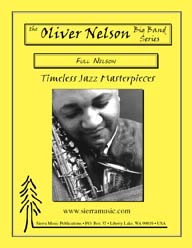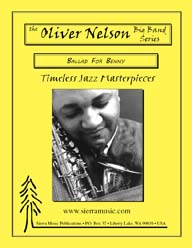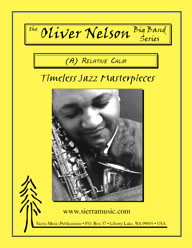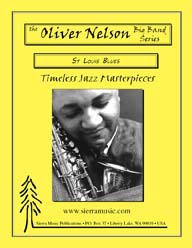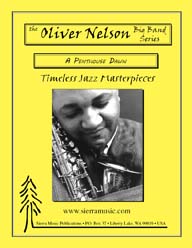PETER AND THE WOLF
Recorded by Jimmy Smith
Arranged by Oliver Nelson, Prepared by Jeffrey Sultanof, Rob DuBoff, and Dylan Canterbury
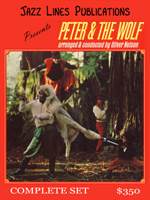
Cat #: JLP-7400
$350.00This item usually ships within 1 business day.
Questions?
Please call +1-518-587-1102 or email us.
Edition: Jazz Studio Orchestra Arrangement
Description: Advanced
Publisher: Jazz Lines Publications
This is one of the truly classic, large-scale jazz compositions ever recorded:
Oliver Nelson's interpretation of Prokofiev's Peter and the Wolf, as recorded by organist Jimmy Smith for Verve Records in 1966.
Nelson arranged this work for jazz orchestra and added much of his own blues- and rock-oriented music, primarily to provide a solo sections for Jimmy Smith. The instrumentation calls for 6 woodwinds (who all double), 4 trumpets, 2 horns in F, 3 trombones, bass trombone, rhythm section, and a percussion section.
From the original liner notes, written by Oliver Nelson:
Six months after the Bolshevik Revolution of 1917, Serge Prokofiev decided to leave Russia for an undecided length of time. Then, in 1933, he decided to return to his native land. During the fifteen year period in which he was away, the composer became increasingly sympathetic to Soviet ideology. From this focal point, he used his music to propagandize Soviet ideals and interpret Russian history and culture.
Of all of Prokofiev's compositions interpreting Soviet life and ideals, Peter and the Wolf is one of the most popular of his orchestral works. This symphonic tale, Opus 67, was completed in 1936 with a text written by Prokofiev himself. It was intended for a children's audience but is equally appealing to adults. In addition to this, there is a political aspect underlying this composition which pictures the Wolf as the ruthless aggressor who devours the helpless Duck, menaces the Cat and the Bird, but is finally outwitted by the 'Soviet boy scout,' Peter.
In addition to being an enjoyable piece of music, Peter and the Wolf is invaluable in it original form as a training aid. Prokofiev's primary aim was to acquaint children with the different instruments of the symphony orchestra. Accordingly, each character is represented by a solo instrument or a group of them.
At the beginning of Side A, there are seven themes which represent the actors in our story. The characters in order of their presentation in the work are:
(A) The Bird, played by the flutes and piccolos; (B) The Duck, played by the oboe; (C) The Cat, played by the clarinets; (D) The Grandfather, played by bass trombones and double bass; (E) The Wolf, played by 2 French horns and trombones; (F) The Hunters, played by the timpani with the Hunters' shots played by the snare drum; (G) Peter, played by two flutes
This version is different in many ways from the original one: this is without narration and it makes use of the jazz orchestra, not the symphony orchestra. Also, the original themes are used but they are now somehow different because of the orchestration. There is new music, too, intended to give this version duration and to give Jimmy Smith a suitable environment in which to improvise. And this version is not politically suggestive one way or the other.
With the Duck swimming in the pond and the Bird hopping along with shore, Peter notices a Cat creeping through the grass and stalking the little Bird. The Bird sees the Cat and flies to safety in a tall tree in the meadow.
Peter's Grandfather has found the open gate and is very angry that Peter has disobeyed him. He has good reason to be concerned because hungry wolves have been seen in the area. Peter is on his way back to the house when a wolf with greedy eyes comes out of the forest and into the meadow. The Bird flies out of range, the Cat runs up the tall tree but the Duck in her panic, jumps out of the pond and tried to run away. Needless to say, she doesn't make it.
Peter, having observed all this, decided to capture the Wolf. He runs into the house, gets a stout rope, climbs into the tree, while the Bird runs the Wolf crazy by flying all about his head. Peter lowers the rope and catches the wolf tightly by the tail. The more the wolf tries to free himself, the tighter the rope becomes.
Hunters who have been tracking the Wolf come out of the forest with their guns blazing, but Peter cried out to them not to shoot – but to help him take the wolf to the zoo.
With their sinister foe safely caged, they take him to the zoo with peter and his friend, the Bird, at the head of the parade.
- Oliver Nelson
Woodwind 1: Piccolo/Oboe, C Flute, Alto Flute
Woodwind 2: Clarinet/Alto Sax.
Woodwind 3: Clarinet/C Flute/Alto Sax./Alto Flute
Woodwind 4: Clarinet/Piccolo/C Flute/Tenor Sax./Alto Flute
Woodwind 5: Clarinet/Tenor Sax.
Woodwind 6: Piccolo/C Flute/Bass Clarinet/Baritone Sax.
4 Trumpets
2 Horns in F
3 Trombones
Bass Trombone
Guitar
Organ (or Keyboard)
Bass
Drums
2 Timpani
Percussion 1: Xylophone/Finger Cymbals/Tambourine
Percussion 2: Triangle (Large and Small)/Crash Cymbal/Snare Drum
Percussion 3: Bells/Bongo Drums
Trumpet 3: C#6
Trombone 1: B4


